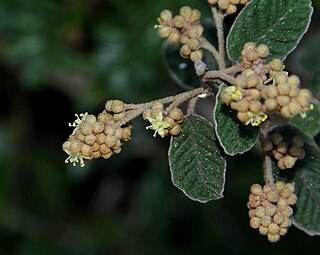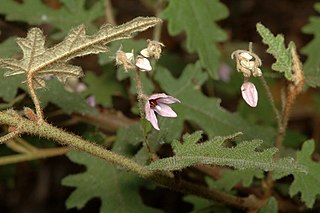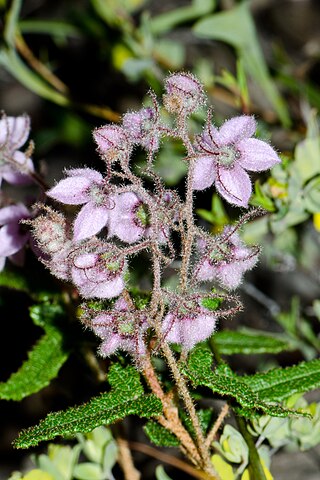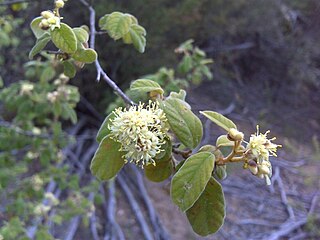
Lasiopetalum behrii, commonly known as the pink velvet bush, is a species of flowering plant in the family Malvaceae and is endemic to southern continental Australia. It is an erect shrub with lance-shaped, narrowly oblong to narrowly elliptic leaves and groups of white to pink and reddish-brown flowers.

Lasiopetalum floribundum, commonly known as free flowering lasiopetalum, is a species of flowering plant in the family Malvaceae and is endemic to the south-west of Western Australia. It is an erect or spreading shrub with hairy young stems, egg-shaped leaves and pale pink, mauve or white flowers.

Lasiopetalum macrophyllum, commonly known as shrubby velvet bush, is a species of flowering plant in the family Malvaceae and is endemic to south-eastern Australia. It is a shrub with egg-shaped to lance-shaped with rust-coloured hairs on the lower surface, and woolly-hairy, cream-coloured and reddish flowers.

Pomaderris oraria, commonly known as Bassian dogwood, is a species of flowering plant in the family Rhamnaceae and is endemic to south-eastern Australia. It is a compact shrub with hairy branchlets, hairy, elliptic leaves and panicles of hairy, greenish to cream-coloured or crimson-tinged flowers.

Pultenaea ferruginea, commonly known as large bronze bush-pea, is a species of flowering plant in the family Fabaceae and is endemic to eastern Australia. It is an erect shrub with hairy stems, narrow egg-shaped leaves with the narrower end towards the base, and yellow to reddish-orange flowers with reddish-brown markings.
Lasiopetalum adenotrichum is a species of flowering plant in the family Malvaceae and is endemic to the Fitzgerald River National Park in the south of Western Australia. It is an erect shrub with hairy foliage, narrow egg-shaped to lance-shaped leaves and groups of white to cream-coloured and dark reddish-purple flowers.
Lasiopetalum cenobium, is a species of flowering plant in the family Malvaceae and is endemic to a restricted part of the south-west of Western Australia. It is only known from the type location, not having been collected since 1918.
Lasiopetalum compactum, is a species of flowering plant in the family Malvaceae and is endemic to the south-west of Western Australia. It is an erect shrub with leathery, narrowly oblong leaves and cymes of white to pinkish flowers.

Lasiopetalum drummondii is a species of flowering plant in the family Malvaceae and is endemic to the south-west of Western Australia. It is an erect, slender shrub with many densely hairy stems, egg-shaped or oblong leaves and white, pink and red flowers.
Lasiopetalum ferraricollinum is a species of flowering plant in the family Malvaceae and is endemic to the south-west of Western Australia. It is an upright shrub with densely hairy stems, narrow egg-shaped to oblong leaves and white to cream-coloured and dark red flowers.

Lasiopetalum glutinosum is a species of flowering plant in the family Malvaceae and is endemic to the south-west of Western Australia. It is a spreading, multi-stemmed shrub with densely hairy young stems, egg-shaped leaves often with three lobes and bright pink or dark red flowers.
Lasiopetalum laxiflorum is a species of flowering plant in the family Malvaceae and is endemic to the south-west of Western Australia. It is a sticky, straggling subshrub or shrub with many densely hairy stems, egg-shaped leaves, and bright pink and dark red flowers.
Lasiopetalum longistamineum is a species of flowering plant in the family Malvaceae and is endemic to a restricted area of New South Wales. It is a spreading shrub with its branches densely covered with woolly, rust-coloured hairs and has egg-shaped leaves and woolly-hairy flowers.
Lasiopetalum monticola is a species of flowering plant in the family Malvaceae and is endemic to the south-west of Western Australia. It is an erect, slender or straggling shrub with densely hairy branchlets, leaves and flowers, egg-shaped leaves and pink, cream-coloured or white flowers.

Lasiopetalum oldfieldii is a species of flowering plant in the family Malvaceae and is endemic to the south-west of Western Australia. It is a low, spreading shrub with rusty-hairy young stems, egg-shaped to narrowly egg-shaped leaves and pink and dark red flowers.

Lasiopetalum oppositifolium is a species of flowering plant in the family Malvaceae and is endemic to the south-west of Western Australia. It is an open, erect shrub with rusty-hairy young stems, linear, narrowly elliptic or narrowly egg-shaped leaves and white, pink and dark red flowers.

Lasiopetalum pterocarpum, commonly known as wing-fruited lasiopetalum, is a species of flowering plant in the family Malvaceae and is endemic to a restricted area in the south-west of Western Australia. It is an open shrub with many densely hairy stems, egg-shaped and lobed leaves and pink and dark red flowers.

Lasiopetalum trichanthera is a species of flowering plant in the family Malvaceae and is endemic to a restricted area in the south-west of Western Australia. It is an erect to straggling, sticky shrub with many hairy stems, egg-shaped leaves and bright pink and dark red flowers.

Lasiopetalum venustum is a species of flowering plant in the family Malvaceae and is endemic to a restricted area in the south-west of Western Australia. It is an erect shrub with hairy stems, egg-shaped, three-lobed leaves and pink and dark red flowers.

Pomaderris subcapitata is a species of flowering plant in the family Rhamnaceae and is endemic to south-eastern continental Australia. It is a shrub with hairy stems, elliptic to egg-shaped leaves and dense clusters of cream-coloured or yellow flowers.













